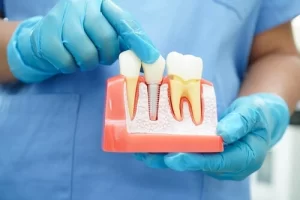After dental implant surgery, which includes a bone graft, many people are surprised by how the mouth reacts in the first few days. Mild swelling, tenderness, and warmth around the graft site can feel unsettling, but these sensations are part of your own body’s natural healing process. You might notice puffiness near the surgical site or slight bruising across the gums and jaw. Most people find that with correct rest, cleaning, and postoperative care, the swelling after dental implant bone graft eases quickly. Knowing what to expect and when to seek professional advice helps you recover comfortably and protect your new implant.
Understanding Swelling After A Dental Implant Bone Graft
Swelling is one of the first visible signs that your body is healing after surgery. Let’s explore why it happens, how long it lasts, and when it needs attention.
What Happens During Dental Implant Surgery And Bone Grafting

Normal Swelling Versus Warning Signs To Watch For
Some puffiness after surgery is expected, especially within the first week. The face may feel tight and slightly warm, and gentle swelling often peaks around day two or three. However, increased swelling that develops suddenly, or pain that worsens rather than improves, could indicate infection or complications. Bad taste, persistent bleeding, or difficulty opening your mouth also warrant review. Early intervention prevents infection from spreading and safeguards the implant site. Keeping the surgical site clean and following care instructions helps your body heal effectively and reduces further irritation.
How Your Body Begins Healing And Building New Bone
Healing after a dental bone graft is a gradual process that takes time and patience. In the early stages, your body sends nutrients and blood cells to the area, creating the framework for new bone growth. This phase can last at least two weeks as the grafted material fuses with your jawbone. As new bone develops, the graft site becomes stronger and more stable, forming the foundation that supports the implant. Although this process happens quietly beneath the gums, it’s essential to maintain rest and a soft diet so the graft stays undisturbed during integration.
When Swelling Might Indicate Infection Or Other Complications
Occasional tenderness or mild pain is normal, but severe pain, pus, or heat radiating from the surgical area could mean infection. Gum disease, smoking, or medical conditions such as diabetes can slow the healing process and increase the risk of complications. Trauma to the area, even from brushing too firmly, may also delay recovery. Prompt evaluation allows your dentist to adjust treatment, prescribe antibiotics, or perform simple adjustments to prevent implant failure. Monitoring your body closely during recovery ensures any warning signs are addressed before they threaten the implant’s long-term success.
Caring For Your Mouth After Surgery And Supporting Long-Term Healing
Good recovery habits protect your graft, reduce swelling, and help your implant heal properly. Here, we outline what to do at home to stay comfortable and prevent problems.
Safe Ways To Reduce Swelling And Manage Discomfort
Using ice packs for short intervals during the first 24 hours helps reduce swelling and relieve discomfort. Keep your head elevated when resting or sleeping to prevent fluid build-up in the grafted area. Most people find this simple step shortens recovery time. Avoid hard foods or unnecessary pressure on the gums to allow the bone to stabilise. Gentle movement, hydration, and avoiding smoking all support circulation and healing. Pain relief medications or antibiotics prescribed during your recovery are safe to use as directed and can prevent infection and inflammation.
How To Keep The Surgical Site Clean And Prevent Infection
Keeping the surgical site clean is an effective way to avoid complications. Rinse your mouth gently with a saltwater solution or an antibacterial mouthwash, as directed by your dentist. Avoid vigorous swishing, which can dislodge the clot protecting the healing bone. Continue daily cleaning of nearby teeth and gums with a soft brush to maintain oral hygiene without disturbing the graft. Your goal is to keep the area clean while letting the tissue regenerate naturally. Consistent care promotes a healthy mouth and a smooth recovery.
Eating Soft Foods And Following A Gentle Recovery Diet
A soft diet supports healing and reduces strain on your graft site. Stick to soft foods like yoghurt, mashed vegetables, or soup, especially during the first week. Eat soft foods slowly and avoid chewing on the side of your implant site. Hard foods can disturb the new bone or cause bleeding. A balanced diet helps your body repair bone tissue more effectively, while proper hydration prevents dry mouth and promotes circulation. Rest when needed, and give your mouth time to adapt before returning to normal foods.
Why Follow-Up Appointments And Oral Hygiene Matter For Implant Success

Resuming Light Exercise After Surgery
Gentle movement supports circulation and healing, but it’s recommended to rest during the first few days after surgery. Light walking can usually resume once swelling begins to ease, provided there’s no discomfort. Avoid bending, heavy lifting, or strenuous workouts until your dentist confirms full stability of the graft site. Gradual activity helps prevent bleeding and supports steady recovery. Listening to your body and stopping at the first sign of pressure or fatigue helps protect the graft and surrounding tissues.
Protecting Your Healing Implant For Lasting Comfort
Swelling after a dental implant bone graft is a sign that your body is working to heal and strengthen the grafted area. Most swelling fades naturally within a week when you follow the right postoperative care routine. If you notice severe pain, infection, or unusual swelling, a professional assessment can prevent further complications. A well-healed graft provides a secure base for your implant, restoring function and comfort. Paying attention to small changes in your mouth helps identify early signs of healing or concern before they become serious. Gentle routines, consistent rest, and good oral hygiene all contribute to a smooth recovery. For personal advice and support during your recovery, contact our clinic today at 07 4801 7035 to book your appointment.
Note: Any surgical or invasive procedure carries risks. Before proceeding, you should seek a second opinion from an appropriately qualified health practitioner.
References
https://pmc.ncbi.nlm.nih.gov/articles/PMC3722694/
https://www.healthline.com/health/dental-bone-graft
